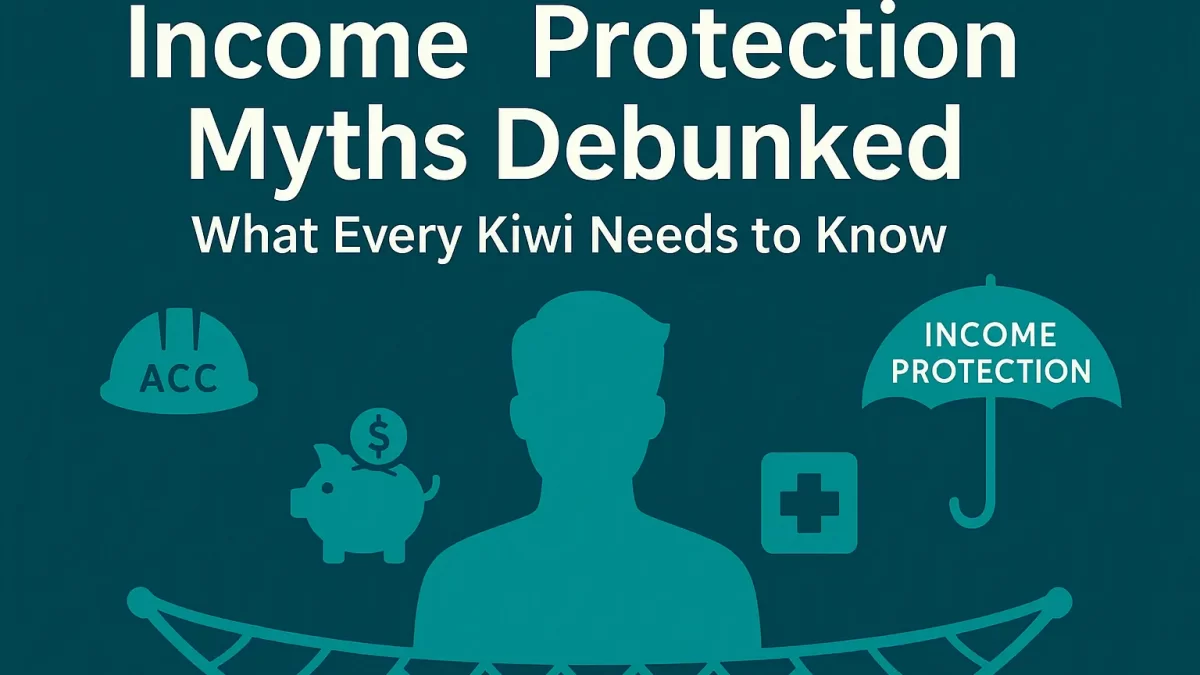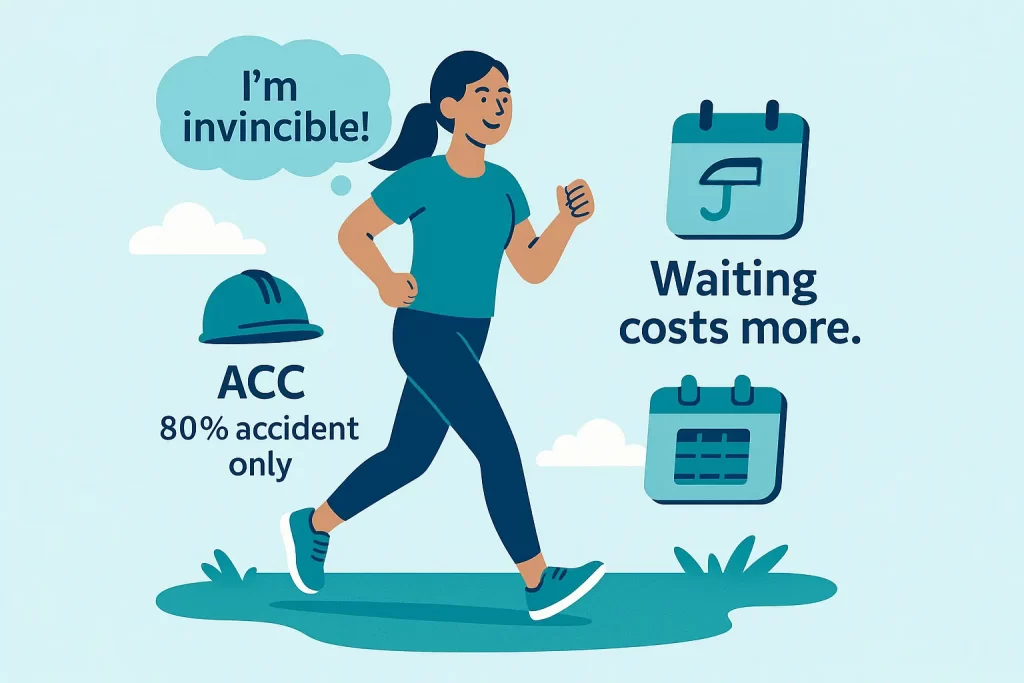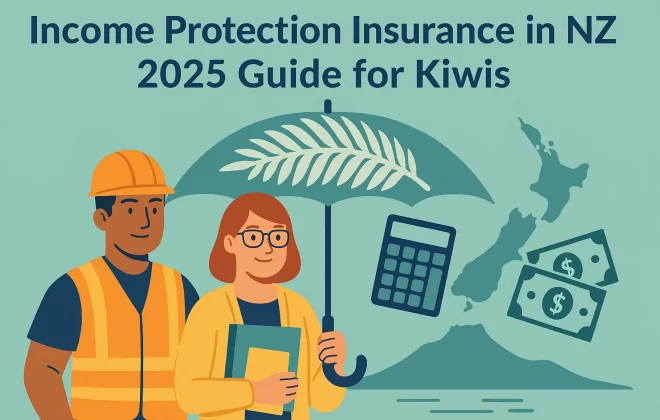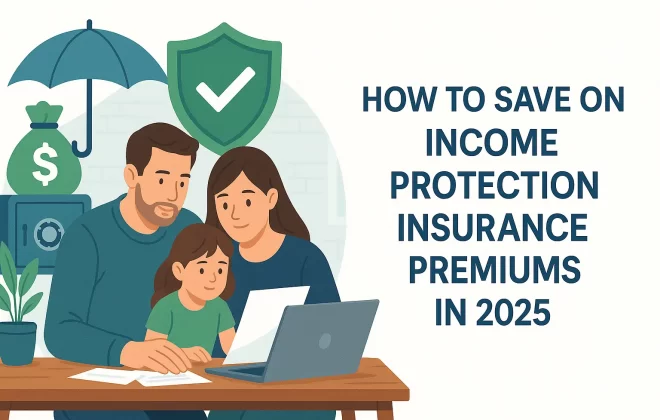Income Protection Myths Debunked: What Every Kiwi Needs to Know
Income Protection Myths can leave even the most prepared Kiwi dangerously exposed when illness or injury strikes. Income protection insurance replaces up to 75% of your pre-tax earnings if you can’t work—bridging the gaps left by ACC’s accident-only cover, public healthcare’s treatment-only scope and personal savings that run out far too fast.
In this deep dive, you’ll discover:
- Myth Cluster A: Why relying on ACC, free healthcare, or WINZ isn’t enough
- Myth Cluster B: How youth, savings and employer cover give a false sense of security
- Myth Cluster C: The truth about cost, complexity and claim approvals
- Myth Cluster D: Exactly what income protection does—and doesn’t—cover
By the end of this deep dive into Income Protection Myths, you’ll see why each myth falls short—and how the right income protection policy can keep your mortgage, rent and daily bills paid, no matter what life throws at you. Let’s bust these myths once and for all!
Myth Cluster A – Over-Reliance on Government & Public Safety Nets
Myth 1: ACC covers everything.
One of the most pervasive Income Protection Myths is that ACC covers everything. Let’s unpack why that isn’t true.
Reality: The Accident Compensation Corporation (ACC) only provides weekly compensation for accident-related injuries, capped at around 80% of your pre-tax salary. It offers no cover for illnesses (cancer, heart disease, mental health) or gradual-onset injuries. Without income protection, you receive zero support from ACC if you’re off work due to sickness, despite illness being one of the most common reasons for long-term absence.
Myth 2: New Zealand’s free healthcare system is sufficient.
Reality: Public healthcare pays for many treatments, but does not replace your lost wages. Elective surgeries and specialist referrals often involve long waiting lists, meaning you could be off work for weeks or months without income. Income protection bridges this gap by covering living costs while you wait for treatment and recover
Myth 3: WINZ/Jobseeker Support will be enough.
Reality: Work and Income NZ (WINZ) Sickness Benefit and Jobseeker Support rates are modest and subject to strict eligibility, including asset and partner-income tests. These payments often fall well short of your normal salary, leaving you to cover housing and bills out of pocket. Income protection can pay up to 75% of your pre-disability income, regardless of household circumstances.
Myth Cluster B – Personal Circumstances & Perceived Invincibility
In Income Protection Myths related to personal circumstances, many Kiwis believe they’re invincible.
Myth 4: I’m young and healthy, so I don’t need cover.
Reality: Illness and injury don’t discriminate by age. Starting a policy while young and fit locks in lower, level premiums and fewer exclusions later, avoiding the steep rate hikes or outright refusals you could face if you wait until health issues arise. For more on why early cover pays off, see our deep dive on Income Protection for Young Adults in New Zealand.
Myth 5: My savings will cover me.
Reality: Research from the Financial Services Council shows most working Kiwis have less than six months’ living costs saved, and 40% couldn’t access $5,000 in an emergency without going into debt – a so-called “savings illusion” that leaves many exposed to long-term income loss (Source: Financial Services Council). Income protection provides a steady benefit without depleting your savings. To see how you can tailor premiums to your budget, check out our guide on How to Save on Income Protection Insurance Premiums in 2025.
Myth 6: I’m single/no dependents (or only covered by my employer), why do I need income protection?
Reality: If you rely solely on your own income for rent, bills or living expenses—losing it hits you hardest. Employer or group plans often end when you change jobs and may replace only a fraction of your wage. Personal income protection stays with you, is fully portable, and can be customised to replace the income you actually need.
Myth 7: Income protection is only for high-income earners.
Reality: Any regular earner with ongoing costs—such as a mortgage, rent, or groceries—can be devastated by lost pay. Policies scale to your salary, so even modest incomes can secure critical cover without breaking the bank. Flexible waiting periods and benefit terms let you balance cost and protection to suit any budget.
By recognising these personal-circumstance myths, you’ll see why income protection is vital—even for young, single or moderate-income Kiwis. Next up, we’ll tackle the cost and complexity barriers that often discourage people from taking out cover.
Myth Cluster C – Income Protection Myths: Cost & Complexity
Myth 8: Income protection is too expensive for me.
Cost concerns are another frequent Income Protection Myths but here’s why premiums can be tailored to your budget.
Reality: While premiums vary by age, occupation, health status and policy design, income protection can be tailored to suit most budgets, often costing less than a daily coffee when weighed against potential income loss. Key factors and strategies include:
- Waiting Period Adjustments: Opting for a longer waiting (deferred) period—say 12 weeks instead of 4—can reduce premiums by up to 30–40%.
- Benefit Period Choices: Shorter benefit terms (e.g., two years vs. to age 65) also lower your weekly cost.
- Occupation Rating: Higher-risk jobs (e.g., construction) carry modest loadings, but many office-based roles qualify for “standard” or “preferred” rates.
- Health Loading & Discounts: Non-smokers and those with healthy BMI often secure discounted premiums; conversely, minor health loadings usually add only 5–15%.
- Tax Treatment: Although premiums aren’t tax-deductible, payouts are generally tax-free—enhancing net value.
- Value Comparison: A 30-year-old non-smoker earning $60,000 might pay just $15–$25 per week for full cover, compared to potentially $1,150/week in lost earnings.
By strategically choosing your waiting period and benefit term, you can find a balance between cost and protection that fits your financial situation.
Read more on aligning your policy to your cashflow in Choosing the Right Income Protection Waiting Period in New Zealand
Myth 9: Policies are too complicated, and claims often get declined.
Reality: In New Zealand, valid income protection claims see approval rates above 90%, and the process is more straightforward when broken into manageable steps:
- Understand Your Policy Document (PDS): Familiarise yourself with definitions—“total disability,” “partial disability,” exclusions and waiting period.
- Prepare Thorough Documentation: Include GP or specialist reports, employer statements and proof of earnings. The more evidence you provide upfront, the smoother the assessment.
- Submit Your Claim Promptly: Most insurers aim to make a decision within 30–40 days of receiving a complete claim package.
- Follow Up & Engage Your Adviser: Regular check-ins with your adviser or the insurer can resolve queries quickly and keep your claim on track.
- Common Decline Reasons: Non-disclosure of medical history, claiming excluded conditions or missing documentation—not a reluctance to pay genuine claims.
Get the full, step-by-step walkthrough in How to Claim Income Protection Insurance in New Zealand: 2025 Guide
External Resource: For a global perspective on policy structures and best practices, see Income Protection Insurance (Wikipedia)
Myth Cluster D – Misunderstandings of Coverage Details
Myth 10: Income protection only covers serious injuries or illnesses.
Reality: Modern income protection policies go beyond catastrophic events. They typically cover a wide spectrum of health scenarios, including:
- Partial Disablement: If you can work in a reduced capacity (for example, shifting from manual labour to desk duties), you can still claim a proportion of your benefit.
- Mental Health Conditions: Anxiety, depression and stress-related disorders are increasingly recognised and covered, provided you meet the policy’s definition of incapacity.
- Common Ailments: Recurring back pain, sports injuries or long-term conditions like arthritis often qualify if they prevent you from performing your usual job duties.
Explore full feature lists in Income Protection Policy Features Explained
Myth 11: Income protection covers redundancy (job loss).
Reality: Income protection is triggered only by your inability to work due to illness or injury. Redundancy, layoffs or business downturns are not covered events. If redundancy cover is important to you, look into a dedicated redundancy insurance policy or an add-on option. These plans typically provide a lump sum or monthly payment for a set period while you search for new employment.
Myth 12: Income protection pays out immediately.
Reality: Every policy includes a waiting period (also called a deferred period), chosen at application. Standard options range from:
- 2 weeks (for minimal gap cover, aligning with limited sick leave)
- 4–8 weeks (balancing cost and coverage)
- 3–6 months (for much lower premiums)
Payments only begin once that waiting period elapses. Choosing a longer waiting period can significantly reduce your premium—so it’s about matching your emergency savings or employer sick leave entitlement with your policy design.
Myth 13: Income protection covers my entire salary.
Reality: Policies typically replace 65%–75% of your gross income, up to a maximum cap set by the insurer. This percentage aims to:
- Incentivise Rehabilitation: Ensuring you return to work when able (100% replacement may reduce this incentive).
- Keep premiums affordable: Full salary cover would cost substantially more.
Since benefits are generally tax-free in New Zealand, a 75% gross replacement can equate to roughly 80–90% of your net take-home pay. Always verify your policy’s tax treatment and cap limits before applying.
Myth 14: You can’t take out income protection if you’re self-employed.
Reality: Self-employed and contract workers are fully eligible—and in many ways most in need—of income protection. Key points:
- No employer sick leave: You don’t get paid leave, so any downtime directly hits your cash flow.
- ACC limitations: ACC only covers accidental injury, leaving illness unprotected.
- Customisable cover: You can insure a portion of your declared business income, helping smooth out revenue gaps.
Myth 15: Income protection doesn’t cover pregnancy/maternity leave or pre-existing conditions.
Reality: Policies often include specialised benefits and exclusions that are more nuanced than a flat “no cover” rule:
- Pregnancy Premium Waiver: Some insurers waive your premiums during maternity leave while holding your benefit amount in force.
- Pre-Existing Conditions: Full disclosure at application allows insurers to price or exclude specific conditions, but doesn’t automatically bar you from all cover. You’ll still be insured for new or unrelated illnesses and injuries.
Compare income protection now!
Myth 16: Insurance companies rarely pay out on genuine claims.
Reality: In New Zealand, properly prepared claims have a 90–98% success rate. Declines usually result from:
- Non-Disclosure: Failing to declare medical history accurately.
- Policy Exclusions: Claiming for excluded events (e.g., intentionally self-inflicted injuries).
- Insufficient Evidence: Lack of medical certification or documentation.
Working closely with your adviser and following the insurer’s claims checklist ensures a smooth process and a high likelihood of payout. You can learn more about in How to Claim Income Protection Insurance.
Conclusion
Debunking these income protection myths is about more than correcting misconceptions—it’s about securing your financial well-being when illness or injury strikes. By recognising the limits of ACC, public health services and personal savings, you’ll understand why income protection is the essential bridge that keeps your household running and your mind at ease. Dispelling myths like “ACC covers everything” or “I’m too young to need cover” empowers you to choose a policy that truly matches your circumstances and protects your income.
Ready to move beyond Income Protection Myths?
Compare New Zealand’s best income protection providers and find the right plan for your needs now
Latest Post
- Income Protection Insurance vs Life Insurance Policy in New Zealand
- Why Are Income Protection Claims Denied? Common Pitfalls Explained
- How to Choose the Best Income Protection Policy in New Zealand
- Income Protection vs Critical Illness Cover: Best Choice for Kiwis
- Income Protection Myths Debunked: What Every Kiwi Needs to Know






